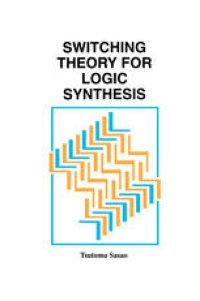
Ebook: Switching Theory for Logic Synthesis
Author: Tsutomu Sasao (auth.)
- Tags: Theory of Computation, Circuits and Systems, Computer-Aided Engineering (CAD CAE) and Design, Electrical Engineering, Discrete Mathematics in Computer Science
- Year: 1999
- Publisher: Springer US
- Edition: 1
- Language: English
- pdf
Switching Theory for Logic Synthesis covers the basic topics of switching theory and logic synthesis in fourteen chapters. Chapters 1 through 5 provide the mathematical foundation. Chapters 6 through 8 include an introduction to sequential circuits, optimization of sequential machines and asynchronous sequential circuits. Chapters 9 through 14 are the main feature of the book. These chapters introduce and explain various topics that make up the subject of logic synthesis: multi-valued input two-valued output function, logic design for PLDs/FPGAs, EXOR-based design, and complexity theories of logic networks.
An appendix providing a history of switching theory is included. The reference list consists of over four hundred entries.
Switching Theory for Logic Synthesis is based on the author's lectures at Kyushu Institute of Technology as well as seminars for CAD engineers from various Japanese technology companies.
Switching Theory for Logic Synthesis will be of interest to CAD professionals and students at the advanced level. It is also useful as a textbook, as each chapter contains examples, illustrations, and exercises.
Switching Theory for Logic Synthesis covers the basic topics of switching theory and logic synthesis in fourteen chapters. Chapters 1 through 5 provide the mathematical foundation. Chapters 6 through 8 include an introduction to sequential circuits, optimization of sequential machines and asynchronous sequential circuits. Chapters 9 through 14 are the main feature of the book. These chapters introduce and explain various topics that make up the subject of logic synthesis: multi-valued input two-valued output function, logic design for PLDs/FPGAs, EXOR-based design, and complexity theories of logic networks.
An appendix providing a history of switching theory is included. The reference list consists of over four hundred entries.
Switching Theory for Logic Synthesis is based on the author's lectures at Kyushu Institute of Technology as well as seminars for CAD engineers from various Japanese technology companies.
Switching Theory for Logic Synthesis will be of interest to CAD professionals and students at the advanced level. It is also useful as a textbook, as each chapter contains examples, illustrations, and exercises.
Switching Theory for Logic Synthesis covers the basic topics of switching theory and logic synthesis in fourteen chapters. Chapters 1 through 5 provide the mathematical foundation. Chapters 6 through 8 include an introduction to sequential circuits, optimization of sequential machines and asynchronous sequential circuits. Chapters 9 through 14 are the main feature of the book. These chapters introduce and explain various topics that make up the subject of logic synthesis: multi-valued input two-valued output function, logic design for PLDs/FPGAs, EXOR-based design, and complexity theories of logic networks.
An appendix providing a history of switching theory is included. The reference list consists of over four hundred entries.
Switching Theory for Logic Synthesis is based on the author's lectures at Kyushu Institute of Technology as well as seminars for CAD engineers from various Japanese technology companies.
Switching Theory for Logic Synthesis will be of interest to CAD professionals and students at the advanced level. It is also useful as a textbook, as each chapter contains examples, illustrations, and exercises.
Content:
Front Matter....Pages i-xi
Mathematical Foundation....Pages 1-16
Lattice and Boolean Algebra....Pages 17-34
Logic Functions and Their Representations....Pages 35-61
Optimization of and-or Two-Level Logic Networks....Pages 63-91
Logic Functions with Various Properties....Pages 93-116
Sequential Networks....Pages 117-138
Optimization of Sequential Networks....Pages 139-150
Delay and Asynchronous Behavior....Pages 151-176
Multi-Valued Input Two-Valued Output Function....Pages 177-199
Heuristic Optimization of Two-Level Networks....Pages 201-228
Multi-Level Logic Synthesis....Pages 229-261
Logic Design Using Modules....Pages 263-288
Logic Design Using Exors....Pages 289-310
Complexity of Logic Networks....Pages 311-320
Back Matter....Pages 331-362
Switching Theory for Logic Synthesis covers the basic topics of switching theory and logic synthesis in fourteen chapters. Chapters 1 through 5 provide the mathematical foundation. Chapters 6 through 8 include an introduction to sequential circuits, optimization of sequential machines and asynchronous sequential circuits. Chapters 9 through 14 are the main feature of the book. These chapters introduce and explain various topics that make up the subject of logic synthesis: multi-valued input two-valued output function, logic design for PLDs/FPGAs, EXOR-based design, and complexity theories of logic networks.
An appendix providing a history of switching theory is included. The reference list consists of over four hundred entries.
Switching Theory for Logic Synthesis is based on the author's lectures at Kyushu Institute of Technology as well as seminars for CAD engineers from various Japanese technology companies.
Switching Theory for Logic Synthesis will be of interest to CAD professionals and students at the advanced level. It is also useful as a textbook, as each chapter contains examples, illustrations, and exercises.
Content:
Front Matter....Pages i-xi
Mathematical Foundation....Pages 1-16
Lattice and Boolean Algebra....Pages 17-34
Logic Functions and Their Representations....Pages 35-61
Optimization of and-or Two-Level Logic Networks....Pages 63-91
Logic Functions with Various Properties....Pages 93-116
Sequential Networks....Pages 117-138
Optimization of Sequential Networks....Pages 139-150
Delay and Asynchronous Behavior....Pages 151-176
Multi-Valued Input Two-Valued Output Function....Pages 177-199
Heuristic Optimization of Two-Level Networks....Pages 201-228
Multi-Level Logic Synthesis....Pages 229-261
Logic Design Using Modules....Pages 263-288
Logic Design Using Exors....Pages 289-310
Complexity of Logic Networks....Pages 311-320
Back Matter....Pages 331-362
....